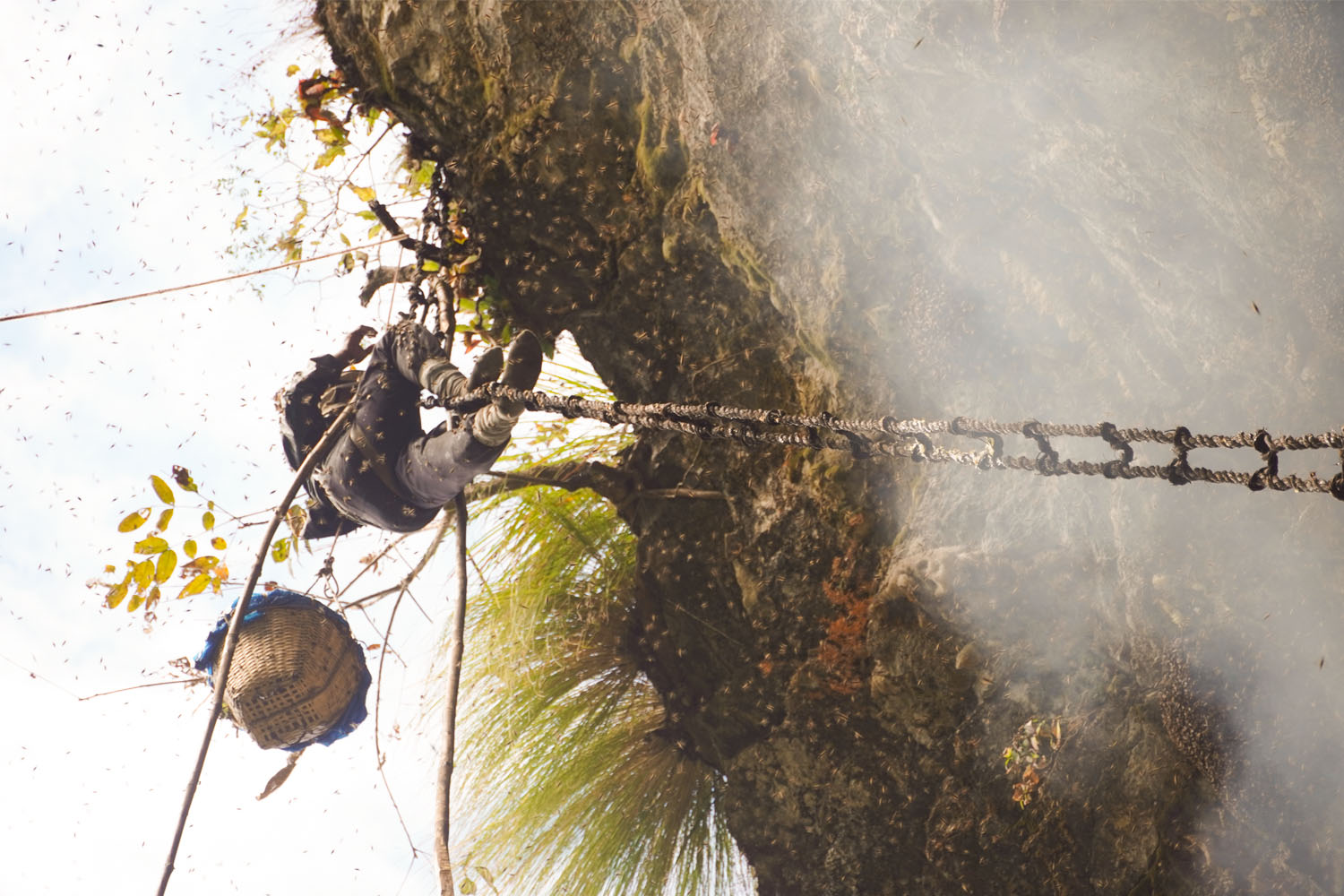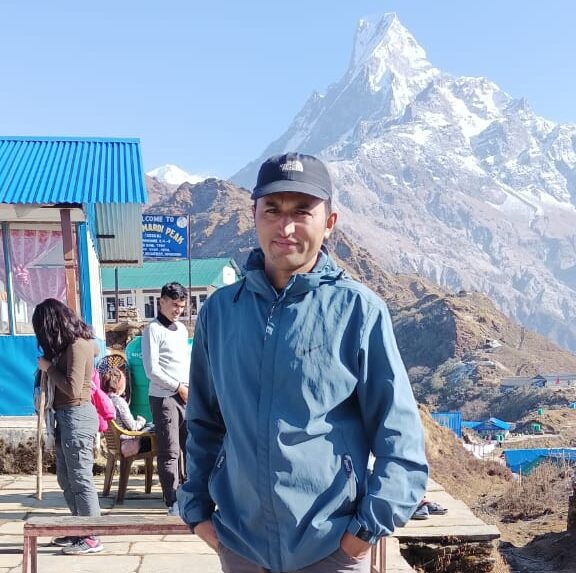
Introduction
Honey hunting in Nepal represents one of the world’s most extraordinary and death-defying traditions. This ancient practice involves harvesting honey from cliff-dwelling giant honeybees, specifically the world’s largest honeybee species, Apis laboriosa. These magnificent creatures build their massive hives on towering cliff faces throughout the Himalayan foothills, creating a spectacle that has captivated travelers and anthropologists for centuries.
The cultural and historical significance of honey hunting runs deep in Nepalese heritage, particularly among the Gurung communities of central Nepal. This remarkable tradition has survived modernization, continuing to play a vital role in local communities while offering visitors an unparalleled glimpse into Nepal’s living heritage. What makes this practice truly unique is the sheer scale and danger involved – honey hunters scale vertical cliff faces hundreds of meters high using nothing but traditional bamboo ladders and hand-woven ropes.
The Tradition of Honey Hunting
The honey hunting tradition in Nepal spans thousands of years, with knowledge and techniques carefully passed down through generations within specific families and communities. This ancient craft follows a sacred rhythm, with honey collection occurring twice annually during optimal seasons when the giant bees are most active and honey production peaks.
The spring harvest typically takes place between March and May, while the autumn collection occurs from September to November. These timing windows align with the natural lifecycle of Apis laboriosa, ensuring maximum honey yield while respecting the bees’ reproductive cycles.
Traditional honey hunting employs remarkably simple yet effective tools that have remained unchanged for centuries. Bamboo ladders, some stretching over 100 feet in length, are handcrafted by skilled artisans using techniques perfected over generations. Hemp ropes, woven from locally grown fibers, provide essential safety lines and support systems. The hunters also use smoking techniques, burning specific plants and herbs to calm the aggressive giant bees during the harvest process.
The actual harvesting involves intricate choreography between multiple hunters, with each person playing a crucial role in the dangerous dance of extracting honeycomb from cliff-side hives. Master honey hunters, known locally as “kuiche,” lead these expeditions with expertise gained through decades of experience.
The Thrill and Bravery
Honey hunting in Nepal demands extraordinary courage and physical prowess. Hunters routinely scale cliff faces reaching heights of 200 to 300 meters, suspended by nothing more than traditional bamboo ladders and hemp ropes. The vertical rock faces offer minimal handholds, requiring hunters to rely entirely on their equipment and years of training.
The risks involved are substantial and very real. Honey hunters face potential falls from extreme heights, aggressive bee attacks from colonies containing thousands of giant bees, and unpredictable weather conditions that can turn deadly within minutes. The giant honeybees themselves present a formidable challenge – their stings are significantly more potent than common honeybees, and the swarms can become extremely aggressive when their hives are disturbed.
Despite these dangers, honey hunters approach their craft with remarkable calm and spiritual preparation. Many perform traditional rituals and ceremonies before each expedition, seeking blessings from local deities and ancestors. This spiritual dimension transforms what could be seen as reckless endangerment into a sacred practice connecting humans with nature.
For visitors, witnessing honey hunting creates an adrenaline-filled spectacle unlike anything else on Earth. The combination of extreme sports, cultural tradition, and natural wonder creates an unforgettable experience that leaves spectators both amazed and humbled by human determination and skill.
Cultural and Community Connection
Honey hunting extends far beyond individual bravery – it forms the backbone of community identity and economic survival in many remote Himalayan villages. The practice generates significant income for local families, with pure cliff honey commanding premium prices in both domestic and international markets due to its exceptional quality and medicinal properties.
During honey hunting expeditions, entire communities mobilize to support the hunters. Women prepare special meals and perform traditional songs, while elders share stories and maintain spiritual oversight of the proceedings. Children learn by observation, gradually absorbing the knowledge they may need to carry the tradition forward.
The community aspect creates exceptional opportunities for cultural exchange between visitors and local people. Tourists participating in honey hunting tours gain intimate access to Gurung villages, experiencing authentic mountain hospitality and learning about traditional ways of life that remain largely unchanged by modern influences.
Local guides and porters involved in honey hunting tourism often come from honey hunting families themselves, providing visitors with genuine insights into the cultural significance and technical aspects of this remarkable tradition. These interactions create meaningful connections that benefit both travelers seeking authentic experiences and communities working to preserve their heritage while generating sustainable income.
The Trekking Experience
The journey to honey hunting locations offers spectacular trekking experiences through some of Nepal’s most pristine and dramatic landscapes. Routes wind through dense rhododendron forests, traditional mountain villages, and terraced agricultural fields that showcase the ingenuity of Himalayan farming practices.
Trekkers enjoy breathtaking panoramic views of snow-capped Himalayan peaks, including glimpses of Annapurna, Manaslu, and other towering summits that dominate the skyline. The diverse ecosystems encountered along honey hunting trails support incredible biodiversity, offering opportunities to spot rare birds, butterflies, and wildlife in their natural habitats.
The trekking component perfectly complements the cultural immersion, creating a comprehensive adventure that satisfies multiple interests simultaneously. Hikers experience varying terrain and elevation changes that provide excellent physical challenges while building anticipation for the honey hunting spectacle itself.
Most honey hunting treks range from 3 to 10 days, depending on the specific destination and route chosen. The trails typically follow ancient trade routes and pilgrimage paths, adding historical depth to the trekking experience while providing glimpses into Nepal’s role as a crossroads between Tibet and India.
Popular Honey Hunting Destinations in Nepal
Nepal offers several renowned honey hunting destinations, each providing unique perspectives on this ancient tradition:
Bhujung stands as perhaps the most famous honey hunting location, known for its dramatic cliff faces and well-preserved traditional practices. The village offers excellent tourist infrastructure while maintaining authentic cultural experiences.
Nai Chi provides a more remote and challenging honey hunting experience, attracting adventurous travelers seeking minimal tourist crowds and maximum cultural immersion. The location features some of the most spectacular cliff colonies in Nepal.
Pasgaon offers accessibility combined with traditional authenticity, making it an excellent choice for first-time honey hunting visitors or those with limited trekking experience.
Naya Gaun presents opportunities to witness honey hunting in a pristine natural setting, with minimal outside influence and strong community traditions still fully intact.
Ludhi provides spectacular mountain views alongside honey hunting experiences, creating perfect combinations of natural beauty and cultural adventure.
Lamjung district encompasses several honey hunting communities, offering varied experiences and excellent trekking opportunities through diverse landscapes and multiple village encounters.
Dare represents one of the more challenging destinations, attracting experienced trekkers and adventure seekers looking for ultimate honey hunting experiences in remote Himalayan settings.
Why Join a Honey Hunting Tour?
Participating in a honey hunting expedition offers truly once-in-a-lifetime adventure opportunities that cannot be replicated anywhere else on Earth. This experience provides rare chances to witness ancient skills and techniques that have survived virtually unchanged for millennia, offering direct connections to humanity’s relationship with nature and traditional survival methods.
Honey hunting tours expertly combine multiple adventure elements – challenging trekking, cultural immersion, wildlife observation, and extreme sports spectacle – into comprehensive experiences that satisfy diverse interests and adventure levels. The tours provide safe, organized access to remote locations and dangerous activities that would be impossible for independent travelers to experience.
Professional honey hunting guides possess intimate knowledge of local traditions, safety protocols, and cultural sensitivities that ensure respectful and meaningful interactions with host communities. These experts help visitors understand the deeper significance of what they’re witnessing while ensuring minimal impact on traditional practices and local environments.
The photographic and videographic opportunities during honey hunting expeditions are simply unmatched. The dramatic cliff faces, traditional costumes, ancient techniques, and stunning Himalayan backdrops create perfect conditions for capturing truly unique and powerful images.
Conclusion
Honey hunting in Nepal represents far more than an extreme adventure activity – it embodies the remarkable resilience of traditional cultures in our rapidly changing world. This extraordinary Himalayan tradition offers visitors unprecedented opportunities to witness human courage, cultural continuity, and the intimate relationship between mountain communities and their natural environment.
The unique combination of death-defying adventure, cultural authenticity, and natural beauty makes honey hunting an incomparable travel experience. Whether you’re drawn by the adrenaline rush of extreme heights, fascination with traditional cultures, love of mountain trekking, or simply the desire for truly unique adventures, honey hunting in Nepal delivers experiences that will resonate long after your return home.
We invite you to discover this extraordinary tradition for yourself. Join the select few who have witnessed the ancient art of honey hunting and experienced the warm hospitality of Nepal’s mountain communities. Book your honey hunting adventure today and become part of this incredible story that continues to unfold on the dramatic cliff faces of the Himalayas.
Posted on



